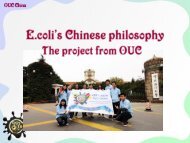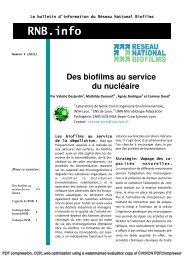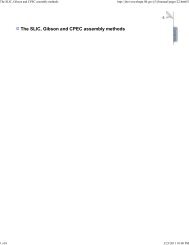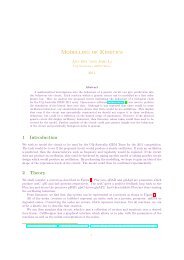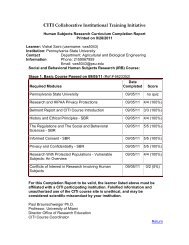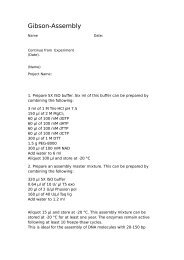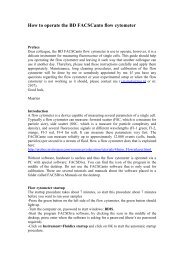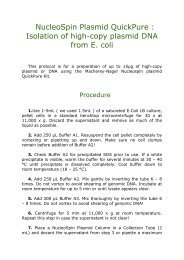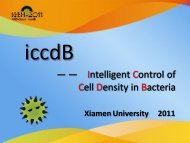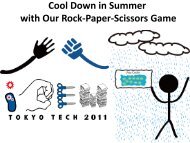Tec-Monterrey Presentation - iGEM
Tec-Monterrey Presentation - iGEM
Tec-Monterrey Presentation - iGEM
You also want an ePaper? Increase the reach of your titles
YUMPU automatically turns print PDFs into web optimized ePapers that Google loves.
A synthetic biology approach<br />
for the sugar cane industry<br />
improvement:<br />
Introducing enzyme surface<br />
display as an alternative to<br />
enzyme immobilization<br />
<strong>iGEM</strong><br />
<strong>Tec</strong>-<strong>Monterrey</strong>
Brainstorm<br />
Last year’s Biosensor<br />
Sulfurafane Metabolic pathway<br />
Curing Cancer
Different Approach<br />
Feasable Project<br />
Social and Economical Impact<br />
Versatile
Mexican Sugar Cane Industry<br />
13.5% National agricultural production<br />
<br />
5.3 million tons of sugar<br />
4.8 million annual tons
57 sugar mills near 277 cities inhabited<br />
by 12 million people<br />
450,000 direct jobs<br />
Benefits 2.2 million
Actual context<br />
Replacement of sugar by sweeteners like high<br />
fructose corn syrup.<br />
Industry of beverages<br />
NAFTA 2008 (North American Free Trade Agreement)<br />
Total cost of sugar production takes 80% of its sales.
Opportunities<br />
2011<br />
Past<br />
sucrose sucrose<br />
bagasse bagasse<br />
11 million tons<br />
(51.8% cellulose)<br />
Imported<br />
fructose<br />
CO 2<br />
emission
Sugar Cane Industry<br />
Advances<br />
Novel Process: Sugar Cane Juice- Fructose
However there is still<br />
room left for optimization…<br />
Enzyme<br />
Overproduction<br />
Enzyme<br />
Purification<br />
Enzyme<br />
Immobilization
Analysis<br />
Economical Impact<br />
Social Impact<br />
Poor handling of byproducts<br />
Expensive downstream<br />
processing, specifically<br />
purification and immobilization<br />
of enzyme
How can we help?<br />
If we can provide a synthetic biology<br />
approach, to improve the sugar cane<br />
industry, then it will gain an added value<br />
by manufacturing valuable products<br />
High Fructose Syroup out of Sucrose<br />
Biofuels substrates out of bagaze (cellulose)
Main Objective<br />
Provide as a proof of concept, a genetic<br />
construction in a model microorganism<br />
(Escherichia coli), capable of displaying<br />
functional enzymes (invertase and cellulase)<br />
outside the cell.
Specific Objectives<br />
1- Selection of a Capable Membrane Proteins<br />
2- Selection of suitable Enzymes<br />
3- Selection of appropriate strains<br />
4- Design of a functional expression cassette<br />
5-Evaluation of the expression of the constructs<br />
6- Messurement of the chimeric enzymes activity
Membrane Proteins<br />
PhoA SP + EstA Fusion<br />
Origin- Pseudomonas aeruginosa<br />
Excression Mechanism: Type V<br />
PhoA SP- Alkalyne Phosphatase<br />
Compatibility- Free C-terminus<br />
Linker + EstA<br />
Membrane Protein<br />
1-Extracellular<br />
Transport Ability<br />
2-Signal Peptide<br />
3-Compatibility<br />
Lpp SP + OmpA Fusion<br />
Origin- Escherichia coli<br />
Compatibility- Free N- Terminus<br />
Excression mechanism: Type II<br />
Lpp SP- Native Lipoprotein
Extracellular<br />
Cellulase<br />
1-Structure<br />
2-Characteristics<br />
3-Active Site<br />
SacC Invertase<br />
Origin- Zymmomonas mobilis<br />
Structure- Monomeric Structure<br />
Characteristics- 20°-40° C, pH 2.5-7.5, 48 kDa<br />
Free N-Terminus<br />
Extracellular<br />
Sucrase<br />
RBS+signal peptide<br />
phoA+Cellulase<br />
CelD Cellulase<br />
Origin- Clostridium thermocellum<br />
Structure- Monomeric<br />
Characteristics- Max 80° C, pH 5-8, 68 kDa<br />
Free C-Termius
Protein Expression Systems<br />
Rosetta Gami<br />
BL21 SI<br />
BL21 Star<br />
XL1Blue<br />
C43<br />
Characterization AraBAD<br />
BW27783<br />
E. coli Strains
Expression Cassette Design<br />
Arabinose<br />
Induced<br />
Constructs
Construct Expression
CelD Expression<br />
Results<br />
o Expected MW<br />
fusion protein<br />
(estA + celD) 102.5<br />
kDa
Device Functionality
CelD + estA Activity<br />
Absorbance @540.0 nm<br />
REDUCING<br />
SUGARS<br />
0.5<br />
0.4<br />
0.3<br />
0.2<br />
0.1<br />
0<br />
DNS<br />
Calibration Curve<br />
y = 0.3085x - 0.0641<br />
R² = 0.982<br />
0 0.5 1 1.5 2<br />
Concentration of Glucose(mM)<br />
Rosetta Gami<br />
Proportional<br />
Colorimetric<br />
Concentration
Rosetta<br />
Gami<br />
Whole-Cell<br />
Cell Lysate<br />
Fraction<br />
Soluble<br />
Insoluble
Glucose Concentration (uM)<br />
400<br />
350<br />
300<br />
250<br />
200<br />
150<br />
100<br />
50<br />
0<br />
T-test<br />
Alpha = 0.05<br />
Ho -> rejected<br />
Whole-Cell Cellulase Activity<br />
C- celD+estA<br />
Whole-Cell Cellulase Activity was determined by IUPAC Filter Paper Assay, with E. coli<br />
strain, Rosetta Gami, negative control and transformed<br />
Suggesting
Glucose Concentration (u M)<br />
Cellulase Activity of Cell lysates<br />
400<br />
350<br />
300<br />
250<br />
200<br />
150<br />
100<br />
50<br />
0<br />
T-test<br />
Alpha = 0.05<br />
Ho -> rejected<br />
SOLUBLE FRACTION<br />
C- celD+estA<br />
Glucose Concentration (u M)<br />
400<br />
350<br />
300<br />
250<br />
200<br />
150<br />
100<br />
50<br />
0<br />
INSOLUBLE FRACTION<br />
C- celD+estA<br />
Cell Lysate Fractions Activity was determined by IUPAC Filter Paper Assay, with E. coli<br />
strain, Rosetta Gami cellular lysate, negative control and transformed with celD+estA
We can conclude that …<br />
Difference between negative control and<br />
estA+celD -> Statiscally significant<br />
Cellulase + estA …. ACTIVE<br />
Activity in C- …. Background signal
Future Work<br />
• Standarize the IUPAC Filter Paper Assay -><br />
more measurements<br />
• LB media -> M9 media or others<br />
• Different E. coli strains<br />
• Another measurement methods e.g.<br />
Benedict method , HPLC
Construct Expression
SacC Expression<br />
Expected MW<br />
fusion protein<br />
(OmpA + SacC)<br />
62.8 kDa<br />
Results<br />
Unclear evidence<br />
vector expression<br />
by SDS-PAGE<br />
+ Coomassie blue
Device Functionality
Whole Cell SacC Activity<br />
Enzyme assay<br />
Enzymatic reaction using<br />
sucrose as substrate<br />
@ pH 5.0, @ 36°C 30 min<br />
Quantification of<br />
released fructose<br />
Colorimetric assay based<br />
on Tetrazole reduction<br />
BL21 SI
BL21SI<br />
t-Test (2 tails, α=0.05)<br />
Rejects the null hypothesys<br />
H 0 = The population means are the same<br />
Tetrazole ---- Fructose
Conclusion<br />
• More Specific Stain<br />
• More measurements<br />
• Different E. coli strains<br />
• Another measurement methods e.g. HPLC
Human Practice<br />
Genes in a Bottle<br />
Molecular biology workshop<br />
Ene.Pé notes<br />
Myths and facts Biotech<br />
MicroCongress
Augmented Biobricks<br />
Synthetic biology<br />
Real time 3D modeling of<br />
your construct
Further Approach<br />
Comparing Raw Data with analytic tests<br />
Eukaryotic systems for heterologous<br />
expression<br />
Sustainable high fructose syrup process<br />
Unit operaations
Thank you.



